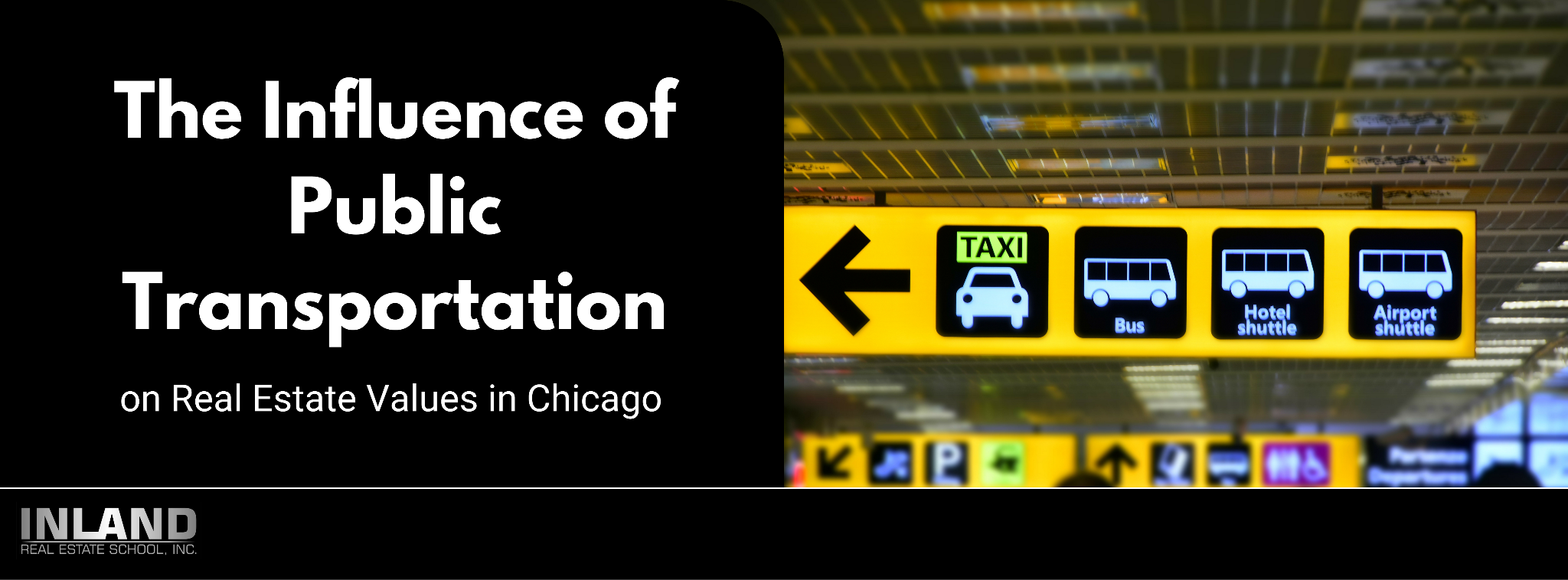
Public Transportation's Impact on Real Estate Values in Chicago
The Influence of Public Transportation on Real Estate Values in Chicago
Introduction
In the bustling metropolis of Chicago, the pulse of the city is often dictated by the rhythm of its public transportation system. This intricate network of trains, buses, and other transit modes doesn't just move people; it significantly influences the urban real estate landscape. Understanding the symbiotic relationship between public transportation and real estate values is crucial for anyone navigating the Chicago property market, be it buyers, sellers, investors, or urban planners. This blog aims to unravel this complex interplay, offering insights into how proximity to transit stations and routes shapes the city's real estate values. It's a story of connectivity and accessibility, where the convenience of public transport converges with the dynamics of property valuation, shaping neighborhoods and influencing the city's growth and development.
In the following sections, we will journey through a historical perspective, understanding the long-standing impact of public transportation on property values. We'll delve into how proximity to transit stations can elevate a property's worth, explore the economic principles at play, and consider the challenges and future trends that shape this ongoing narrative. Join us as we navigate the streets and stations of Chicago, uncovering the undeniable influence of public transportation on its real estate heartbeat.
Historical Perspective
The relationship between public transportation and real estate values in Chicago has a rich history that tells a tale of evolving urban landscapes and shifting homeowner preferences. Historically, properties located near public transportation have not only maintained their value but often have seen a marked increase, even during times of economic downturns. This trend is rooted in the early days of urban development, where proximity to transit routes was a key factor in the growth and prosperity of neighborhoods.
In Chicago, the expansion of the 'L' (elevated train) system in the early 20th century serves as a prime example. Neighborhoods that gained access to these new transit lines experienced a surge in property values, as accessibility to the city's commercial and industrial hubs improved dramatically. This historical trend has persisted over the decades, with properties near train stations and major bus routes consistently fetching higher prices and attracting greater interest from buyers.
This pattern is not unique to Chicago; it mirrors trends observed in other major cities worldwide, where public transportation has played a pivotal role in shaping real estate markets. The historical data underscores a fundamental truth in urban real estate: access to efficient, reliable public transportation is a key driver of property value and desirability.
As we delve deeper into the modern implications of this trend, it's important to consider the historical foundation upon which the current dynamics are built. This perspective not only helps us understand the current real estate market in Chicago but also provides valuable insights for future developments.
Impact of Proximity to Transit
In Chicago, the value of real estate is significantly influenced by its proximity to public transportation, particularly rail transit stations. This phenomenon is a key aspect of urban real estate dynamics, where convenience and accessibility are highly prized. Properties located near 'L' stations, Metra stops, or key bus routes often command higher prices, driven by the demand for easy access to the city's various neighborhoods and business districts.
The reasoning behind this trend is straightforward: being close to public transportation reduces commute times, offers more transportation options, and generally makes life more convenient. For many residents, especially those who work in the city center or frequently travel for leisure or business, living near a transit station is a top priority. This preference translates into a higher willingness to pay for properties that offer such convenience, thus driving up their market value.
Moreover, the areas surrounding transit hubs often develop into vibrant communities with a rich array of amenities like shops, restaurants, and entertainment venues. These amenities further enhance the attractiveness of these neighborhoods, creating a virtuous cycle of desirability and value appreciation.
However, it's essential to note that the impact of proximity to transit can vary based on several factors, including the type of transit (rail vs. bus), the frequency and reliability of service, and the overall appeal of the neighborhood. Generally, neighborhoods with high-frequency and reliable train services tend to see a more pronounced effect on property values compared to those served primarily by buses.
This trend, highlighted in urban studies and real estate analyses, underscores the importance of public transportation infrastructure in urban planning and development. It shapes not only the way people live and commute but also the economic landscape of the city.
Economic Principles Behind Property Value Increases
The relationship between public transportation and property values in Chicago can be understood through the lens of fundamental economic principles, primarily the interaction of demand and supply, land value elevation, and the enhancement of the local economy.
Demand and Supply Interaction: Real estate markets operate on the basic economic principles of demand and supply. Properties in close proximity to public transportation are in high demand due to the convenience and accessibility they offer. This high demand, coupled with the limited supply of such properties (as there's only so much land near each transit station), typically drives up prices.
Land Value Elevation: The presence of efficient public transportation often leads to an elevation in land values. This phenomenon, known as the "transit premium," arises because the land around transit hubs is more desirable. Not only does it offer easier access to other parts of the city, but it also often brings additional development in the form of retail, offices, and services that create vibrant, walkable communities.
Enhancement of the Local Economy: Improved public transportation can bolster the local economy. Efficient transit systems can lead to increased economic activity, as they make it easier for people to access jobs, shopping, and leisure activities. This, in turn, can lead to job creation and higher incomes, which further fuel the real estate market.
Accessibility and Time Savings: Proximity to public transportation reduces travel time and costs, making an area more attractive to live in. This increased accessibility can lead to a higher quality of life, which is a significant factor in real estate valuation.
The interplay of these economic factors creates a compelling argument for the impact of public transportation on real estate values. In cities like Chicago, where the public transportation network is extensive and deeply integrated into the urban fabric, these principles are especially relevant.
Challenges and Considerations
While the proximity to public transportation generally boosts real estate values in Chicago, there are challenges and considerations that must be taken into account:
Noise Pollution and Congestion: One of the primary drawbacks of living near major transit routes is noise pollution. Trains, buses, and the associated activity can be a significant source of noise, potentially detracting from the living experience. Additionally, areas near transit hubs can suffer from higher levels of traffic congestion, impacting the quality of life for residents.
Impact on Neighborhood Character: The development surge around transit stations can sometimes alter the character of a neighborhood. While this can bring positive changes like new amenities and revitalized public spaces, it can also lead to gentrification. This process can displace long-term residents and alter the neighborhood's cultural and socio-economic makeup.
Variable Impact Across Different Areas: The impact of public transportation on property values isn't uniform across all areas. It can vary significantly based on the quality and reliability of the transit services, the overall desirability of the neighborhood, and the specific type of public transportation available (e.g., rail vs. bus).
Maintenance and Upkeep of Transit Infrastructure: The condition and upkeep of public transportation infrastructure can also play a role. Well-maintained, modern, and efficient transit systems are more likely to positively impact real estate values compared to outdated or poorly maintained systems.
Future Transit Developments: The potential for future developments in public transportation can also impact current real estate values. Properties in areas slated for future transit projects may see an increase in value in anticipation of improved accessibility.
These challenges and considerations highlight the complexity of the relationship between public transportation and real estate values. While the overall impact is positive, it's essential for stakeholders to consider these factors for a nuanced understanding of the market.
Future Trends and Predictions
Looking ahead, several trends and predictions are shaping the influence of public transportation on real estate values in Chicago:
Increasing Demand for Transit-Oriented Developments (TODs): There's a growing trend towards Transit-Oriented Developments, which are mixed-use residential or commercial areas designed to maximize access to public transport. These developments are expected to become even more popular, driven by environmental concerns and a shift towards sustainable living.
Millennial and Gen Z Preferences: Younger generations, particularly Millennials and Gen Z, are showing a strong preference for living in transit-accessible areas. Their values, which often include a desire for sustainability, convenience, and urban lifestyles, are likely to continue driving demand for properties near public transportation.
Technological Advancements in Public Transportation: As Chicago invests in modernizing its public transportation system with technological advancements, we can expect an even greater positive impact on surrounding real estate values. Improvements might include more efficient and reliable services, cleaner energy buses, and enhanced commuter experiences.
Shifts in Work Patterns Influencing Transit Needs: The increasing prevalence of remote work could influence the types of transit developments in demand. While downtown areas and business districts have traditionally been focal points, there might be a growing need for enhanced transit access in residential neighborhoods and suburbs.
Impact of Urban Planning and Policies: Future urban planning decisions and policies regarding public transportation in Chicago will play a crucial role. Plans to expand transit networks, improve existing infrastructure, or develop new transit-oriented communities can significantly impact real estate values in the affected areas.
Resilience in the Face of Economic Shifts: Properties near public transit in Chicago are likely to maintain their resilience against economic downturns, as seen historically. The convenience and cost savings associated with living near public transportation can make these properties a safer investment, even in uncertain economic times.
In conclusion, the relationship between public transportation and real estate values in Chicago is poised to remain strong and influential. The evolving preferences of younger generations, coupled with technological advancements and urban planning initiatives, are likely to shape the future landscape of urban real estate in the city.
Conclusion
Reflecting on "The Influence of Public Transportation on Real Estate Values in Chicago," it becomes clear that the city's transit system plays a pivotal role in shaping the real estate market. The historical data underscores a longstanding trend where proximity to public transportation correlates with increased property values. This trend is driven by the practical benefits of accessibility and convenience that public transit offers, making neighborhoods more attractive for living and investment.
However, the impact of public transportation on real estate is nuanced and multifaceted. While it generally boosts property values and contributes to the economic vitality of neighborhoods, it also brings challenges such as noise pollution and congestion. The future of this interplay seems to hinge on several factors, including advancements in public transit infrastructure, evolving urban planning policies, and shifting demographics, particularly the preferences of younger generations like Millennials and Gen Z.
As Chicago continues to grow and evolve, the synergy between public transportation and real estate development will remain a critical area for urban planners, investors, and residents alike. This relationship not only impacts the economic landscape of the city but also influences the quality of life and the sustainability of urban living. Understanding and harnessing this dynamic will be key to ensuring a vibrant, accessible, and prosperous future for Chicago.
WE OFFER OVER
25+
PROGRAMS
WE HAVE SERVED
12000+
STUDENTS
VETERAN STAFF
40+ Years
INDUSTRY EXPERIENCE
PROUDLY PROVIDING
23+ Years
OF EDUCATION
INLAND REAL ESTATE SCHOOL, INC. SUPPORTS

Campus Visiting Hours by appointment only:
1st-18th each month AM times, M-F
19th-end of the month PM times, M-F
Visiting hours need to be scheduled in advance
OAK BROOK, ILLINOIS 60523. © INLAND REAL ESTATE SCHOOL, INC. A PROFESSIONAL STUDIES INSTITUTE, INC. COMPANY, 2010. ALL RIGHTS RESERVED.
NOT AFFILIATED WITH THE INLAND REAL ESTATE GROUP OF COMPANIES, INC. THE INLAND NAME IS USED UNDER LICENSE. Privacy Policy








